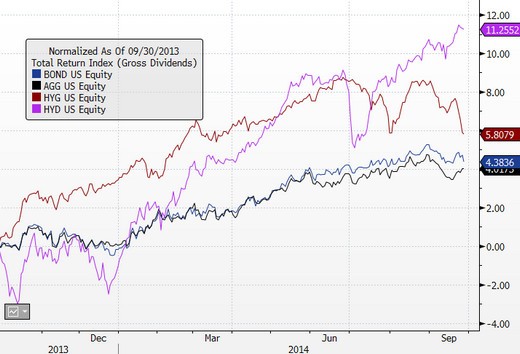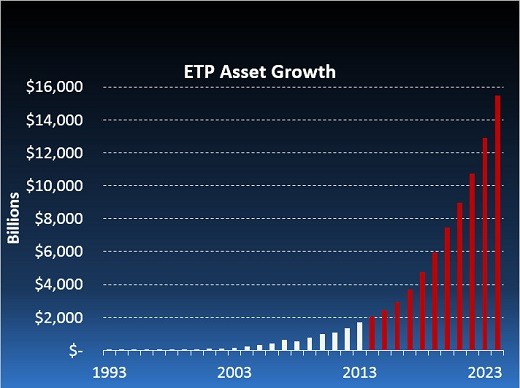Ten iShares ETFs Every Investor Should Know (But Most Don t)
Post on: 14 Май, 2015 No Comment

San Francisco-based iShares. which was acquired by BlackRock from Barclays last year, has more than 180 U.S.-listed ETFs. But the distribution of assets is far from even across these funds. At the end of 2009, the ten largest iShares ETFsonly about five percent of the issuers product lineaccounted for 50% of total assets. So theres obviously a lot more to the iShares product line than the handful of mega-tickersIVV. EFA. TIP. and AGG. just to name a fewthat every ETF investor knows. Below, we highlight ten iShares ETFs that may deserve a closer look for inclusion in your portfolio.
10. Russell MicroCap Index Fund (IWC )
While virtually every investor has exposure to large and mega cap stocks, the same cannot be said for the smaller end of the the spectrum. These securities, which tend to fall into a market capitalization range of between $50 and $550 million, only comprise 3% of the domestic equity market but can often provide investors with diversification benefits and significant growth opportunities due in large part to their small size and growth potential.
Investing in individual micro cap equities is often a very risky business, making this segment of the equity market a great fit for the ETF structure. The fund currently has more than 1,3oo stocks with no one equity comprising more than 0.70% of total assets ensuring. In a corner of the market where bankruptcies and triple digit returns are both relatively common occurrences, this diversification is potentially very valuable. IWC is heavily weighted towards financials (22.6%), technology, (17.7%) and healthcare (16.7%) while offering minimal exposure to utilities and transportation. IWC charges an expense ratio of 0.60%, a reasonable fee for broad exposure to the smallest of the small.
See this Guide to Micro-Cap ETFs for a closer look at IWC and other competing products.
9. MSCI Chile Index Fund (ECH )
When many investors think of rapidly investments in South America, Brazil usually comes to mind. But theres a lot more to this hot-bed of growth than EWZ. Despite its importance to world economy, Chile continues to fly under the radar of many international investors. Currently, iShares is the only issuer that provides access to this dynamic South American country in ETF form. The fund is heavily weighted towards mining and industrial companies, which make up a significant portion of the Chilean economy and nearly 40% of ECH. This is reflective of the importance of copper to the Chilean economythe metal is the single largest contributor to the governments coffers. ECH charges an expense ratio of 0.63% and is up an impressive 52% over the past 52 weeks, thanks in large part to the rapidly increasing price of copper over 2009. For more information about investing in Chile, see this feature article: Forget the BRIC Your Portfolio Needs the TICK .
8. MSCI Kokusai Index Fund (TOK )
TOK is a good example of why investors should never judge an ETF by its name. This fund invests in 22 developed markets around the globe with one notable exception: Japan. While many developed market ex-U.S. funds exist, TOK is one of the few global ETFs that excludes Japan instead of the United States, a feature that has paid off in recent years as the Japanese economy has stalled. TOK is well diversified with over 1,200 holdings and no one security comprising more than 1.75% of the fund. TOK has a heavy tilt towards U.S. equities, which comprise just over 50% of the total assets. The next two largest countries in the fund are the United Kingdom (11.2%) and France (5.4%), with Canada and several European markets rounding out the top ten.
After experiencing incredible growth in the 80s Japanese markets have been mired in a twenty year lost decade of minimal growth. With mounting deficits and negative population growth, many investors are concerned that this trend will continue into the next decade as well. For investors who believe that the Japanese economy will be stuck in the doldrums and left in the dust by its other developed market counterparts, this fund could be a good way to access a diversified index of companies. TOK has an expense ratio of just 0.25% and is up more than 30% over the past year.
7. MSCI All Peru Capped Index Fund (EPU )
Much like the Chilean fund, iShares is the only ETF issuer to provide access to Peru, another rapidly developing South American market. Although Peru has a much lower GDP per capita than its neighbor to the south, the country has a population almost twice as large. This is due in large part to the free market reforms of President Fujimori in the mid 1990s, a painful period at the time that laid the foundation for opening the country up to investment from foreign nations. Peru has been growing at a steady clip ever since and is poised for long term growth due to its vast reserves of sought after commodities such as gold. copper, and oil.
The fund only holds 26 companies and is heavily concentrated in the minerals sector, with two-thirds of assets going to mining companies. The two largest components of the fund, both mining firms, make up 34% of the total assets. EPU charges an expense ratio of 0.63%.
6. Diversified Alternatives Trust (ALT )
ALT, one of the newest iShares products, represents the companys first foray into the range of hedge-fund like ETFs. The objective of this fund is to maximize absolute returns from investments in non-traditional asset classes such as forwards, swaps, and futures while seeking to control the risks and volatility inherent in instruments by taking long and short positions in historically correlated assets. This objective is accomplished by using three strategies: technical analysis, yield and futures curve arbitrage, and fundamental relative value comparisons. By exploiting these trends, the fund hopes to produce a Sharpe ratio between 0.50-0.75 with an average portfolio volatility of between 6%-8%.
This may be appropriate for investors seeking to limit their volatility and produce consistent real returns. Although the fund is unlikely to produce outsized gains, it could offer some investors peace of mind who have heavy positions in more traditional low risk investments such as bonds. Currently, the fund has significant long holdings in AUD/USD forwards and short-term Euribor instruments, while maintaining short positions in CHF/USD forwards and 10 year Japanese bonds. It is important to note that ALT is an active fund, meaning that these positions could change rapidly in order to conform to new market data or opinions.
5. MSCI Belgium Index Fund (EWK )
The tiny European country of Belgium is often overshadowed by the much larger France and Germany, but as the seat of the European Union the country commands significant political influence and presents an intriguing option for international developed market exposure. Like most of its neighbors, Belgium has a highly advanced economy and focuses on services and manufacturing for the vast majority of its GNP. Another strong aspect for Belgium is its location as the crossroads between France and Germany. This has allowed the country to develop a robust transportation network as well as impressive shipping facilities which form the cornerstone of the modern Belgian economy.
The fund, which charges 0.52% for an expense ratio, has performed very well over the past 52 weeks, up an impressive 50%. The fund is heavily concentrated in beverage giant In-Bev, which makes up just over 25% of the fund. In addition to consumer staples, which make up about 35% of EWK, financials are another large component, comprising 31% of the total assets. For investors who believe in a consumer and financial sector rebound, EWK may be an interesting choice.
4. S&P North American Technology-Multimedia Networking Index Fund (IGN )

One of the most significantly segmented ETFdb Categories is the technology ETF category. Among the several interesting niche funds is IGN, which seeks to track an index of U.S. traded multimedia networking stocks. The index includes companies that are producers of telecommunication equipment, data networking and wireless equipment. It is primarily a large cap fund holding technology behemoths such as Cisco, Qualcomm, and Research In Motion which combine to make up more than 21% of the total assets. The fund charges an expense ratio of 0.48% and although it is down almost 6% in 2010, the fund is up nearly 50% over the last year.
3. FTSE EPRA/NAREIT Asia Index Fund (IFAS )
Investors burned by the collapse of the U.S. real estate market have been hesitant to add this asset class back to their portfolios. Although real estate prices in the U.S. and, to some extent, Europe continue to stagnate, Asian property markets have surged in recent months, and could continue to appreciate if government stimulus measures remain in place and incomes and populations in developed Asian markets continue to rise. IFAS focuses on developed markets in the region (meaning no exposure to the potentially-overheated mainland China), with more than 97% of the fund going to Hong Kong, Japan, Australia, and Singapore. The funds 76 holdings are spread across various types of REITs, with residential real estate making up 57% of the fund. Rounding out the top three are retail REITs (17.6%) and industrial and office REITs (10.2%). The fund is up more than 40% over the past 52 weeks and charges an expense ratio of 0.48%.
2. S&P Global Nuclear Energy Index Fund (NUCL )
The alternative energy sector has received a fair amount of investor attention in recent months, with high hopes for solar and wind energy being called into question by waning government support and inability of global leaders to identify definitive plans for emissions reduction. With mounting budget deficits and more pressing international issues, leaders from various political parties have indicated desire to expand the role played by nuclear power in the global energy industry.
With just over $15 million in assets, NUCL is a relatively small fund that has big potential. Much has been made on the need to develop alternative energy sources in the coming decade, but the majority of the attention has focused on technologies that are yet to be proven as sustainable and cost efficient, such as wind, solar, and hydro power. The climate change issues has been divisive politically, but nuclear power is one point on which both parties seem to agreeeven Sarah Palin and Barack Obama share a similar viewpoint .
1. AMT Free Municipal Bond Series
For high tax bracket investors seeking to limit their taxable income, iShares recently introduced a series of AMT free municipal bond ETFs which invest in securities that are exempt from federal taxes and the Alternative Minimum Tax (see this feature covering the launch of the funds). The line of muni bond ETFs from iShares are different from existing funds in that each focuses on debt issues maturing in a certain year, allowing investors to fill in holes in the fixed income portion of their portfolios or fine-tune the overall duration.
The line of AMT-Free muni bond ETFs includes six funds focusing on debt issues maturing between 2012 and 2017 (see a closer look at these funds here ). These targeted new products have the potential to be extremely useful in a number of ways, allowing investors and advisors to fill in holes in fixed income portfolios and implement customized strategies. Each fund in the series charges an expense ratio of 0.30%.
For a complete list of iShares ETFs click here. For more ETF ideas, sign up for our free ETF newsletter .
Disclosure: No positions at time of writing.














